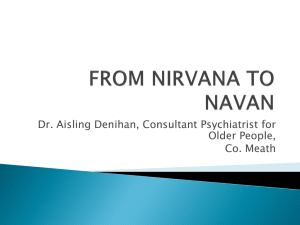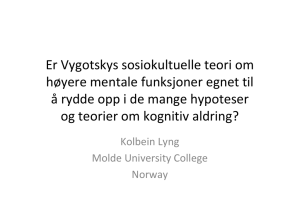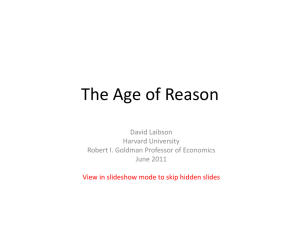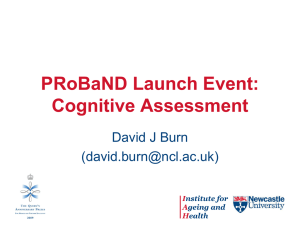GERI conference
advertisement
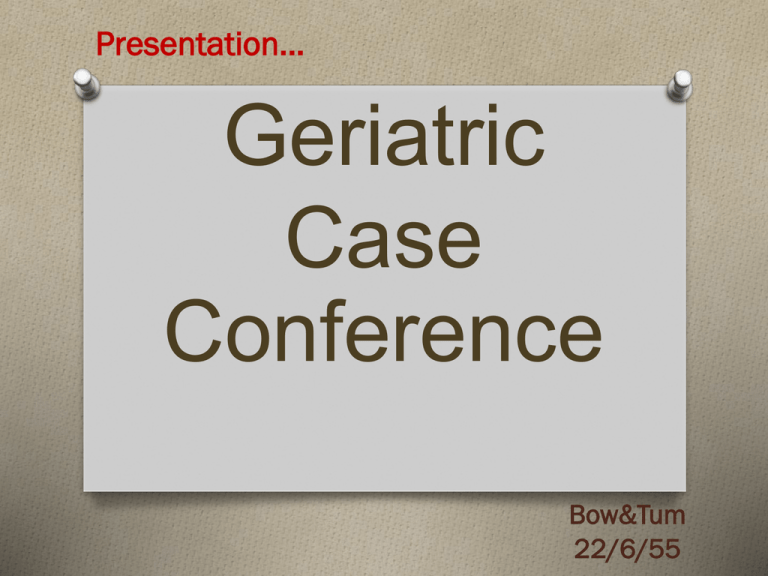
Presentation… Geriatric Case Conference Bow&Tum 22/6/55 Patient profile O ผู้ป่วยหญิงไทยโสด อายุ 60 ปี O อาชีพ รับราชการครู ปั จจุบนั เกษี ยณแล้ ว (สอน สังคมศาสตร์ ม.ต้ น รร.ปทุมคงคา) O การศึกษา ปริ ญญาตรี O ภูมิลาเนา จ.นนทบุรี O ศาสนา พุทธ O สิทธิการรักษา ข้ าราชการ Chief complaint หลงลืม 5 ปี Present illness 5 ปี ก่อน เริ่มมีอาการหลงลืมเรื่ องทีเพิง่ ทาไป อารมณ์ฉนุ เฉียว โกรธง่าย หวาดระแวง มีปัญหาใน การทางานที่โรงเรี ยน อาศัยอยูค่ อนโดคนเดียว Present illness ปี 2550 ผู้ปกครองมาแจ้ งทางโรงเรี ยนว่า อ.อิ่มให้ การบ้ านนักเรี ยน วาดแผนที่ทกุ วันซ ้าๆ เริ่มมีปัญหาเรื่ องการสอนที่โรงเรี ยน จัดแผนการสอน ผิด เขียนใบเสร็จไม่ถกู ต้ อง ทางโรงเรี ยนจึงพิจารณาย้ ายจากอาจารย์สอน วิชาสังคมมาเป็ นอาจารย์ฝ่ายแนะแนว เริ่มมีพฤติกรรมก้ าวร้ าว ด่าว่าเพื่อนครูในโรงเรี ยน เพื่อนครูจงึ แนะนา ให้ เกษี ยณก่อนกาหนด และแจ้ งให้ ญาติทราบ เนื่องจากผู้ป่วยอาศัยอยูค่ น เดียวที่คอนโดมาตลอด ญาติไปพบที่คอนโดว่าปล่อยให้ รกรุงรัง เดินแก้ ผ้าใน ห้ อง รื อ้ เสื ้อผ้ า ลืมรับประทานอาหาร Present illness ญาติพาผู้ป่วยเข้ ารับการรักษาที่รพ.พระมงกุฎฯ ได้ รับยา และติดตามอาการ แต่ยงั มีอาการสับสน เห็นภาพหลอน เช่น พูด คนเดียวกับกระจก พูดไม่เป็ นคา เรี ยงประโยคผิด อารมณ์เสียง่าย ชอบด่าว่าญาติและพูดเหตุการณ์เก่าๆ ญาติเป็ นกังวลมากและคิด ว่าผู้ป่วยแกล้ ง และคิดว่าผู้ป่วยเป็ นโรคทางจิต ต่อมาอาการสับสน เพิ่มมากขึ ้น ญาติจงึ พามารักษาที่รพ.รามาธิบดี Genogram คุณหล่าน คุณเปี๊ ยก 62 ปี ตู่ 41 ปี ตรอง 21 ปี 2nd AD Dx 40+ yrs CA Colon 72 ปี 1st คุณธาริณี 60 ปี ตัก๊ 20 ปี คุณดารี รัตน์ คุณโด้ ง CA liver 56 ปี 58 ปี โอม 25 ปี ไอซ์ 21 ปี ดิว 23 ปี แอ๊ น 20 ปี คุณต๋ง CA liver 47 ปี แตม 17 ปี Timeline 2517-2519 2520 2517-2531 2531 • บรรจุราชการครูที่สงขลา • ย้ ายกลับมาสอนที่กรุงเทพฯ • สามีคณ ุ หล่านไปมีภรรยาใหม่ •สามีคณ ุ หล่านกลับมาคืนดี •ทะเลาะกับสามีคณ ุ หล่านจนต้ องย้ ายไปอยู่คอนโด Timeline กพ.2551 •ผอ.รร.เรี ยกญาติพบ อ.อิ่มไม่ปรกติประมาณ 1 ปี ไม่ สามารถสอนหนังสือได้ ทางรร.ให้ ย้ายจากกลุม่ สาระ ไปกลุม่ กิจการแทน 2551 • Early retirement • เริ่มเขียนหนังสือไม่ถกู 2552 •ทาของหายบ่อยๆ เช่นเอกสาร เงิน •กินยาไม่ถกู •เริ่ มใช้ คารุนแรงด่าพี่น้อง จินตนาการความคิดเอง Timeline 2553 • ใส่เสื ้อผ้ าไม่ถกู เช่นกลับตะเข็บ ใส่ซ้อนหลายตัว • คุยกับทีวี กระจก หูแว่ว คิดว่าคนอื่นด่า หัวเราะเยาะ • น้ อยใจว่าตัวเองถูกทอดทิ ้ง อิจฉาพี่น้อง 2554 • ย้ ายไปอยู่ Nursing Home, ญาติพาไปรักษาที่รพ. พระมงกุฎฯ คิดว่าเป็ นโรคจิต • ย้ ายมารักษาที่รพ.รามาธิบดี • เยี่ยมบ้ านครัง้ ที่ 1 Problems list Differential diagnosis New Dementia Criteria Loss cognitive or neuropsychiatric symptom O Interfere with work or usual activities O Decline from prior level of functioning เสีย ADLs O Not explained by delirium or other psychiatric disorder R/O other cause Loss cognitive or neuropsychiatric symptom Behavior Memory Language Executive function Visuospatial Impairment ≥ 2 Physical Examination GA : หญิงไทยแต่งตัวดี สะอาด ไม่ค่อยแสดงสีหน้ า BP 120/80 mmHg PR 70/min HEENT : not pale, anicteric sclera, normal tooth & gum, no oral lesion LN : no cervical LN enlargement Heart : regular, normal s1,s2, no murmur Lung : clear, equal both, no adventitious sound Abd: soft, no mass, not tender ,no hepatosplenomegaly Physicial Examination Ext : No edema, no cogwheel rigidity, no spastic, no resting tremor N/S : pupil 3 mm. RTLBE, full EOM, motor power gr. V all, BBK – plantar flextion both Gait : normal Speech : normal 28/6/54 24/1/55 28/2/55 ครั ง้ ที่ 1 ครั ง้ ที่ 2 ครั ง้ ที่ 3 0 1 3 0 2 2 0 3 2 0 0 2 0 0 2 0 0 2 Writing command 0 1 0 0 1 1 1 0 1 Wristing 0 0 0 Visuo-contruction 0 0 0 7 8 9 Test/Date Orientation for time Orientation for place Registration Attention/Calculation Recall Naming Repetition Verbal command คะแนนรวม Test/Date CDT Test/Date Cube 28/6/54 24/4/55 ครัง้ ที่ 1 ครัง้ ที่ 2 2/10 1/10 28/6/54 24/4/55 ครัง้ ที่ 1 ครัง้ ที่ 2 incorrect Incorrect Dementia? Severity? Investigation Investigation CBC WBC 5200 Hb 12.7 RBC morpho N 60 L 31 M 6 E 2 Hct 40.9 MCV 89 MCH 27.2 normochromia Cr 0.77 TSH 1.646 (0.35-4.94) Vitamin B12 338.5 (243.0-894.0) VDRL NR B 1 MRI brain O Mild volume loss of hippocampi and parahippocampal gyri with thining of entorhinal cortex, bilaterally which may be represent Alzheimer disease. O The bilateral pars compacta of the substantia nigra of the midbrain are well identified. O The rest of brain parenchyma shows normal signal intensity without space occupying lesion. Brainstem and the cerebellum are unremarkable. The calvarium and the skull base have normal marrow signal intensity. No midline shifting, hydrocephalus or extraaxial collection is detected. Impression O Mild volume loss of hippocampi and parahippocampal gyri with thining of entorhinal cortex, bilaterally which may be represent Alzheimer disease. O Generalized mild cerebral volume loss. FDG PET O The study reveals severely decreased FDG activity in bilateral parietotemporal cortices which is relative symmetric. There is also mildly to moderately decreased FDG activity in the frontal cortices, right slightly involved more than left. The tracer distribution in the rest of the scanned regions appears within normal limits. Limited low dose, noncontrast CT images show no corresponding abnormality. Impression O Severe hypometabolism of bilateral parietotemporal cortices with less involvement of frontal cortices favor Alzheimer’s disease, less likely Pick’s disease. Diagnosis Clinical Features Distinguishing AD and Other Dementias O AD: O Memory, language, visual-spatial disturbances, indifference, delusions, agitation O Frontotemporal dementia: O Relative preservation of memory and visual-spatial, skills, personality change, executive dysfunction, excessive eating and drinking O Lewy body dementia: O visual hallucinations, delusions, extrapyramidal, symptoms,fuctuating mental status, sensitivity to antipsychotic medications O Vascular dementia: O abrupt onset, stepwise deterioration, executive dysfunction, gait changes Cognitive domain AD DLB bvFTD VaD Depression Free recall +++ ++ +/- + + Recognition +++ - - - - Prompting X √ √ √ √ Intrusions +++ +++ +++ + + Semantic memory (naming) ++ + + + +/- - + - + + Procedural memory Cognitive domain AD DLB bvFTD VaD Depressi on Working memory ++ +++ +++ ++ +/- Insight +++ + +++ - - Attention ++ +++ ++ ++ +++ Executive functions ++ typical AD +++ frontal variant +++ +++ +++ ++ ++ typical AD +++ PCA +++ - + + Visuospatial skills Memory impairment in AD Memory impairment in AD Memory impairment in AD Memory impairment in AD Memory impairment in AD Alzheimer’s dementia criteria O Probable AD O Possible AD O Probable or possible AD with evidence of the AD pathophysiological process O Biomarkers of brain amyloid-beta (Ab) protein deposition O Biomarkers of downstream neuronal degeneration or injury Atypical AD O Logopenic progressive aphasia O Language O Frontal variant AD O Behavior, Executive O Posterior cortical atrophy O Visuospatial Frontotemporal dementia FTD FTD O Dementia in persons younger than 65 years O A neurodegenerative disease of unknown etiology O Behavioral and language O Relatively preserved memory O Neuroimaging (MRI) usually demonstrates frontotemporal atrophy Types of FTD O Behavioral variant frontotemporal dementia O Semantic dementia O Progressive nonfluent aphasia Treatment Medication O Rivastigmine patch(10) 1 patch แปะ q 24 hr O Memantine (10) 1 x 1 oral pc O Sertraline(50) 1 x 1 oral pc O Na valproate chrono(500) 1 x 1 oral pc O Quetiapine (25) 1 x 1 oral hs O Amlodipine (5) 1 x 1 oral pc O Folic (5) 1 x 1 oral pc O Vitamin B1612 1 x 2 oral pc Therapeutic strategies O Symptomatic treatment O Disease-modifying therapy O Lifestyle O Diet O Physical Exercise O Mental Exercise Cholinesterase Inhibitors O Donepezil, Rivastigmine, Galantamine O Mild to moderate dementia O Benefit in severe dementia not as clear Memantine O Mechanism of action: partial NMDA-receptor antagonist O May block glutamate excitotoxicity O May provide symptomatic benefit via effects on hippocampal neurons O Moderate to severeAlzheimer’s dementia O Safe in combination with ChEI Pharmacologic Treatment of Agitation Symptoms Medication Agitation in context of nonacute psychosis Olanzapine 2.5–10 mg/d Quetiapine 12.5–100 mg/d Risperidone 0.25–3 mg/d Agitation in context of depression SSRI, eg, citalopram 10–30 mg/d Anxiety, mild to moderate irritability Trazodone 50–100 mg/d Agitation or aggression unresponsive to first-line treatment Carbamazepine 300–600 mg/d Olanzapine (intramuscular) 2.5–5 mg IM Sexual aggression, impulse-control symptoms in men Second-generation antipsychotic If no response, conjugated equine estrogens 0.625–1.25 mg/d Diet O Mediterranean diet (Scarmeas N. JAMA. 2009) O High in vegetables, legumes, fruits, nuts, cereal, fish, olive oil O Low in saturated fats O Up to 40% reduction in risk for developing dementia Non pharmacological treatment in dementia O Cognitive focus intervention O Cognitive stimulation O Cognitive training O Cognitive rehabilitation O Other O Music therapy O Aromatherapy O Massage and touch O Exercise Cognitive rehabilitation is an individualised approach where personallystimulation is Cognitive relevant are is identified Cognitivegoals training guided engagement in a range and the therapist works with practice on a set of standard ofthe activities and person and his or her tasks family to devise strategies discussions (usually in to a designed to reflect particular address group) aimed at general cognitive functions; a range of these. The emphasis is on difficulty enhancement of improving performance in levelsmay be available within cognitive andsetsocial everyday life the standard of tasks to functioning. rather than on cognitive tests, suit building on the person’s the individual’s level of ability. strengths It may be offered in individual and or developing ways of compensating for impairments group sessions, with pencil and paper or computerised exercises. Cognitive stimulation O Control group : usual activity O Doing nothing O Game : bingo, singing, art and crafts O Intervention : programme O 14-session programme , twice a week, 45min per session over 7 weeks O Reality orientation and cognitive stimulation O Topic : using money, word games, the present day and famous faces O Reality orientation board Cognition Follow up O Communication and social interaction • QoL • GDS O ADL, Behavior, caregiver non significant Cognitive training and cognitive rehabilitation O Cognitive training : 9 studies O Cognitive rehabilitation : none Change in MMSE CHANGE in… O Immediate verbal memory scores O Delayed verbal memory scores O Verbal letter fluency scores O Verbal category fluency scores O Executive function scores O Self-report of memory functioning O Participant self-report of mood (depression) O Informant report of participant memory functioning CHANGE in… O Informant report of participant mood (depression) O Informant report of participant functional ability O O O O O (ADLs) Informant report of informant reaction to participant memory and behaviour problems (Follow up) immediate verbal memory scores (Follow up) executive function (sequencing) scores (Follow up) informant report of participant memory functioning (Follow up) informant report of participant functional ability (activities of daily living) Music therapy O Type of music therapy O Receptive music therapy O Active music therapy Total minute spent not wandering during all sessions of main therapy Mean change in MMSE Number of agitated behavior 2 week 4 week Massage and touch O The use of hand massage for an immediate and short-term reduction of agitated behaviour O The addition of touch to verbal encouragement to eat for the normalization of nutritional intake Mean agitate score Aroma therapy O Only 2 RCT, other not good study design O Statistical significant in decreased agitated Evaluation of Response to Any Cognitive Enhancer O Elicit caregiver observations of patient’s cognitive function and behavior (alertness, initiative) and follow functional status (ADLs and instrumental ADLs). O Follow cognitive status (eg, improved or stabilized) by caregiver’s report or serial ratings of cognition (eg, Mini-Cog, MMSE) 28/6/54 24/1/55 28/2/55 ครั ง้ ที่ 1 ครั ง้ ที่ 2 ครั ง้ ที่ 3 0 1 3 0 2 2 0 3 2 0 0 2 0 0 2 0 0 2 Writing command 0 1 0 0 1 1 1 0 1 Wristing 0 0 0 Visuo-contruction 0 0 0 7 8 9 Test/Date Orientation for time Orientation for place Registration Attention/Calculation Recall Naming Repetition Verbal command คะแนนรวม Test/Date CDT Test/Date Cube 28/6/54 24/4/55 ครัง้ ที่ 1 ครัง้ ที่ 2 2/10 1/10 28/6/54 24/4/55 ครัง้ ที่ 1 ครัง้ ที่ 2 incorrect Incorrect Follow up Follow up MMSE O •Hallu/Delu •Apathy •Depression •Agitation •ManicTypical AD MMSE drop like/attention ≥ 3/yr Caregiver ADLs/ iADLs Cognitio n Sleep Function Safety GI,drop GU,≤ 2/yr •REM O MMSE cardio,temp, BPSD •Insomnia work dysphagia O Advance directive !!! •Increase ANS sleep day Driving, falling, Neuro financial THANK YOU



